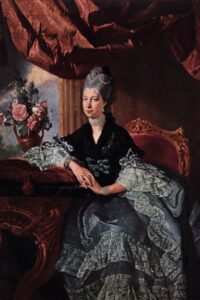
The theory that Queen Charlotte may be the first mixed race or Black British royal begins with the genetic research of historian Mario De Valdes y Cocom, who began his studies in 1967, according to the Washington Post.
“Queen Charlotte, wife of the English King George III (1738-1820), was directly descended from Margarita de Castro y Sousa, a Black branch of the Portuguese Royal House,” Valdes wrote for PBS’ Frontline.
According to the Washington Post, Valdes said that Portuguese royal Alfonso III’s mistress Ouruana was a Black Moor. He pointed to Charlotte’s physician using the outdated and offensive term “mulatto” to describe her appearance. He also said a prime minister depicted her in a racist manner by describing stereotypical features, writing: “Her nose is too wide and her lips are too thick.”
Valdes also observed various portraits of Queen Charlotte, noting they featured the royal with a darker skin tone and curly hair.
“Six different lines can be traced from English Queen Charlotte back to Margarita de Castro y Sousa, in a gene pool which because of royal inbreeding was already minuscule, thus explaining the Queen’s unmistakable African appearance,” he wrote. “The… characteristics of the Queen’s portraits certainly had political significance since artists of that period were expected to play down, soften or even obliterate undesirable features in a subject’s face.”
Despite Valdes’s research (that features outdated and offensive language) other historians dispute his findings.

“The word ‘blackamoor’ in Shakespeare’s time meant Muslim,” University of Pennsylvania professor Ania Loomba told The Philadelphia Inquirer. “It didn’t mean Black necessarily. Moors could be white from North Africa.”
As for the Palace’s thoughts on the matter? A spokesman told The Boston Globe: “This has been rumored for years and years. It is a matter of history, and frankly, we’ve got far more important things to talk about.”
Queen Charlotte’s husband, King George III, struggled with mental illness.
In Bridgerton, despite the unflappable regal exterior she shows to the public, we get a glimpse into Queen Charlotte’s private life as she deals with the progressive decline of her husband King George III’s mental state.
As it turns out, Queen Charlotte and King George III were a doting couple whose first 25 years of marriage were spent happily, according to the Historic Royal Palaces website. However, more than two decades after his first “bout of mental illness” that was kept hidden from the queen, in 1788 King George III experienced a month-long manic episode that left him unable to fulfill his royal duties. This was the first of four instances of illness across the next 32 years that earned him the infamously tasteless title “The Mad King,” and permanently fractured his and his wife’s close relationship.
The king succumbed to mania in 1811, which meant their oldest son George, The Prince of Wales, became regent until his father’s death in 1820. Charlotte was loyal to her husband and acted as his guardian her own death in 1818, according to the royal family’s website.
For years it has been theorized that a genetic blood disorder called porphyria caused King George III’s mental decline. This idea is depicted in the Oscar nominated 1994 film, The Madness of King George, starring Helen Mirren and Nigel Hawthorne. But modern research rejects this diagnosis, with the BBC reporting in 2013 that doctors found many of the king’s symptoms mimicked someone “experiencing the manic phase of psychotropic illnesses such as bipolar disorder.”
